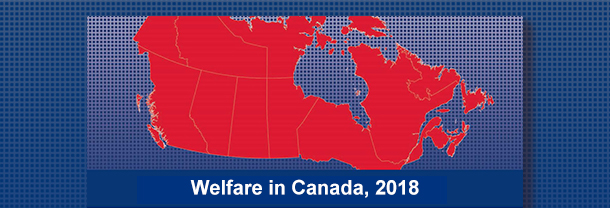Welfare in Canada update now available
Posted on November 14, 2019 in Social Security Delivery System
Source: Maytree.com —
Maytree.com – Policy & Insights
Nov. 13, 2019.
Today, Maytree is releasing the latest Welfare in Canada report showing the total income households on social assistance would have received in 2018 (i.e., their income from social assistance alongside tax credits and child benefits).
The report looks at how welfare incomes varied across every province and territory for four example households in 2018:
- Single person considered employable
- Single person with a disability
- Single parent with one child age two
- Couple with two children ages 10 and 15
Using data provided by provincial and territorial government officials, the report describes the components of welfare incomes, how they have changed from previous years, and how they compared to low income thresholds.
Key findings:
- In 2018, total welfare incomes did not keep pace with the cost of living in 33 of the 52 scenarios tracked in this report (four household types across the 13 provinces and territories). In these cases, households receiving welfare were worse off in 2018 than they were in 2017.
- There were only two jurisdictions – Nunavut and British Columbia – where the welfare incomes rose by more than the cost of living for all of the four household types considered.
- In Nunavut, welfare incomes rose due to the restructure of, and increase to, basic social assistance payments in July 2018.
- In British Columbia, the increase in 2018 welfare incomes was driven by a $100 rise in monthly social assistance payments for all household types which came into effect in October 2017.
- Even where welfare incomes were highest, they fell short of the poverty threshold. The closest was in Quebec where the welfare income of a single parent reached 85 per cent of the poverty threshold and in PEI where welfare incomes for a couple with two children also reached 85 per cent of the threshold.
- The welfare incomes in the Yukon and the Northwest Territories were generally higher than in the provinces, reflecting the higher cost of living in the territories. Conversely, welfare incomes in Nunavut were lower than in the provinces, reflecting the high proportion of households on social assistance living in subsidized housing whose living costs are reduced through housing subsidies.
_______________________________________Access data and download report Spread the word
This resource was previously compiled by the Caledon Institute of Social Policy which wound down in 2017. To help people find the new home of Welfare in Canada, please share this email with anyone who would find it useful. To stay informed about Maytree’s policy and research work, including the future editions of Welfare in Canada and Social Assistance Summaries, subscribe to Policy Update.https://maytree.com/welfare-in-canada/
Tags: budget, disabilities, housing, jurisdiction, poverty
This entry was posted on Thursday, November 14th, 2019 at 9:09 am and is filed under Social Security Delivery System. You can follow any responses to this entry through the RSS 2.0 feed. You can skip to the end and leave a response. Pinging is currently not allowed.

 Recent Comments
Recent Comments